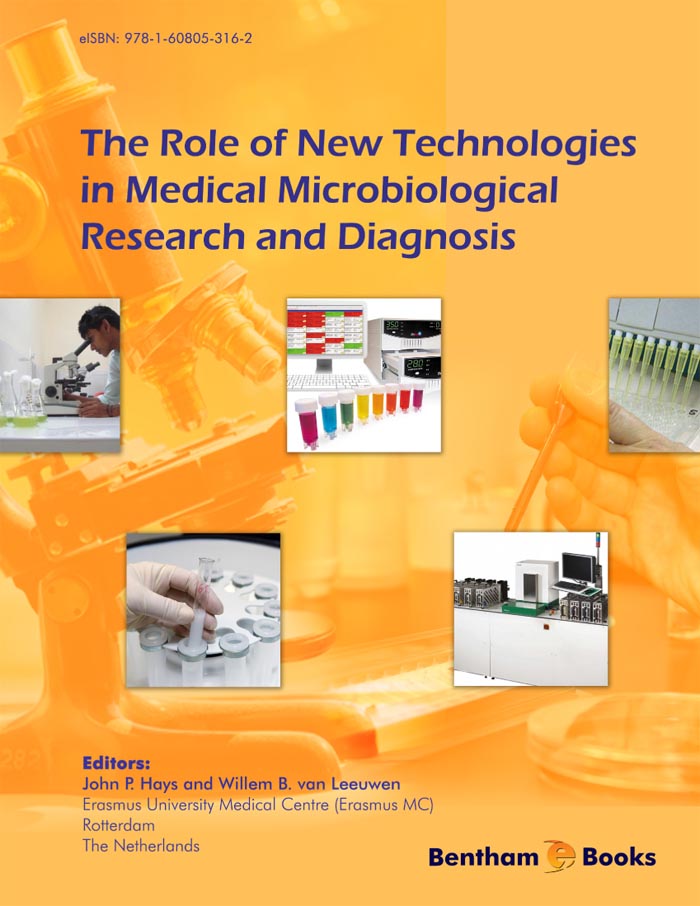Bentham Science Publishers
Bentham Science Publishers is a major publisher of more than 100 peer-reviewed science, technology and medical (STM) journals, along with a rapidly growing collection of eBooks. Since 1993, Bentham Science Publishers has been catering to the information needs of the pharmaceutical, engineering, biomedical and medical research community.1741 - 1760 of 1881 results
-
-
The NLRP3 Inflammasome: An Attentive Arbiter of Inflammatory Response
More LessInflammation triggers specific metabolic pathways and if not resolved, translates into several painful diseases such as rheumatoid arthritis, lupus, Alzheimer's disease, cardiovascular disorders and psoriasis. Various processes have been explored to understand the factors behind inflammation and consequently, many mechanisms have been examined to suppress it. The nucleotide-binding domain like receptor 3 (NLRP3) inflammasome is an example of such factors which is responsible for triggering sterile and microbe induced inflammation. Studies of genetic variants of the related gene have revealed insights into the mRNA expression pathways that may help researchers to identify crucial disease mechanisms.
This book is a review of the scientific findings of distinguished scholars who have studied NLRP3 inflammasome activation and its contribution in worsening the outcomes of inflammatory disorders.
This collection of chapters covers many aspects of the multifaceted role of NLRP3 inflammasome. Beginning with airway inflammation and fibrosis, it progresses to explore its involvement in pulmonary hypertension, heart diseases, tuberculosis, cardiovascular complications, and childhood asthma. Additionally, it examines the inflammasome's impact on protozoan parasitic infections and neuropathic pain. The chapters not only elucidate the intricate mechanisms of NLRP3 activation but also discuss potential inhibitors and therapeutic targets. Readers will gain a comprehensive understanding of the NLRP3 inflammasome's diverse implications across different physiological contexts. The book includes references making this book a valuable treatise of insights for researchers, clinicians, and healthcare professionals.
-
-
-
The Paradox In Partnership: The Role of Conflict in Partnership Building
More LessThe Paradox in Partnership: The Role of Conflict in Partnership Building elucidates on alliances that are - on one hand, designed to promote collaboration between individuals, groups and organizations - but on the other hand, the processes of their formation and maintenance entail continuous engagement with competitive orientation, power struggles and conflict. Theoretical frameworks with praxis are integrated as reflected in a variety of organizational, community and national contexts. In the theoretical domain, it expands knowledge on partnerships in general and their paradoxical nature in particular. On the practical level, the dual partnership phenomenon is explained along with considerable advantages it may offer to all partners when it is developed systematically and is accompanied by reflection and learning, especially while facing the reality of dwindling resources.
-
-
-
The Pharmaceutical Scientist Guide to Solution Kinetic Models Mathematical Description and Applications
More LessThermodynamics and kinetics (i.e., chemical interactions) are extremely important concepts for pharmaceutical scientists to understand since the "drug selection process", that is, the process used by pharmaceutical companies to discover and develop marketable drugs, is totally dependent upon these theories. While both theories are important, kinetic models describing complex chemical and biological processes provide a unifying theory for all phases of the discovery and development of drugs. Unfortunately, in most textbooks the mathematical descriptions necessary to develop a deeper understanding of kinetic models are omitted. This is primarily done such that the underlying chemistry and biochemistry principles are not obscured by the "mathematical maze" that is generated from these models. As a result many chemists and biologists veer rapidly away from thermodynamics and kinetics. For some scientists, this can lead to confusion on how to apply these models to real-life situations. For example, many enzyme kinetic models are formulated as rate equations. Since experimentally measurements typically determine concentrations and rarely determines rates directly, confusion arises on how to apply kinetic models. In this case, either the model is integrated to give a description of the concentration course of the enzyme reaction or the data is differentiated (i.e., the process of determining rates) by measuring tangents to the reaction curves at zero time.
The level of mathematical skills required to solve kinetic models is minimal for anyone who has studied college level algebra and calculus. Thus, the objective of this book is to present a brief review of thermodynamics and kinetics followed by a detailed step-by-step approach in developing and solving kinetic models for complex chemical and biological processes. The book focuses on building a solid mathematical foundation of enzyme kinetic models by systematically evolving simple uni- and bi-molecular models to enzyme models. Applications for some of these kinetic models are generated from pharmaceutical examples and a selection of problems is presented at the end of each chapter. This elementary approach has been intentionally selected to keep the book at a self-explanatory level. It is anticipated that the reader will be able to follow the mathematical operations and in the process develop a deeper understanding of kinetic models and an improved ability to interpret kinetic parameters.
The book is restricted to solution chemical kinetics and does not deal with the theories of chemical reactions, gas-phase reactions, experimental kinetic methods and so on. There are many excellent chemical kinetic textbooks available for those interested in these topics. The solution chemical kinetics materials for the book were obtained from literature papers and several books on physical chemistry and enzyme kinetics. The ideas from these sources have been hopefully reinterpreted in a style that is well matched to those pharmaceutical scientists that do not have a comprehensive knowledge of kinetic models and the mathematical skills to solve them.
Chapter 1 presents a general overview to thermodynamic and kinetic principals and theory. In Section i, an overview to the scope of the book is presented. A brief review of mathematical fundamentals used in the book (Section ii) and kinetic and thermodynamic principals are present (Section iii and iv). A glossary of symbols and abbreviation used throughout the book is presented in Section v. Chapter 2 describes the basic theory of first-order kinetic models. These types of mathematical models are used for irreversible (Section I) and reversible (Section II) rearrangement reactions and some examples are presented to illustrate their applications to drug discovery. Chapter 3 describes second-order irreversible (Section III) and reversible (Section IV) dimerization reactions while Chapter 4 describes second-order irreversible (Section V) and reversible (Section VI) binding reactions. Chapter 5 describes partially and fully coupled reversible completive binding reactions (Section VII). Chapter 6 describes second-order kinetic models that are used to analyze consecutive irreversible (Section VIII) and reversible (Section IX) substrate suicide enzyme reactions. Chapter 7 describes kinetic models that are used to analyze consecutive irreversible (Section X) and reversible (Sections XI and XII) enzyme reactions. Chapter 8 describes kinetic models that are used to analyze consecutive reversible inhibition enzyme reactions (Section XIII - XVI). Chapter 9 describes kinetic models that are used to analyze substrate (Section XVII) and product inhibition (Section XVIII) enzyme reactions. The Appendix contains the answers to the problems.
-
-
-
The Polyandrous Queen Honey Bee: Biology and Apiculture
More LessThe queen honey bee is known to mate with multiple drones, and can produce over a million offspring in its lifetime. Its presence is vital to the growth and survival of a beehive. This reference book is a detailed guide to queen honey bees. The book starts by providing deep insights into the fascinating biology of the queen honey bees, their morphometric features, developmental synchronicity, genetics, hormones, pheromones, colonial organization and swarming. Further, the book describes artificial queen rearing techniques that facilitate healthy bee colony growth and increase apiculture productivity. The book equips readers with all the knowledge they need to know about queen bee development, their role in the colony and improving the health of their colony. Key Features - 14 reader-friendly chapters that comprehensively present information about queen honey bees - Comprehensive coverage about queen bee biology, including their physical morphology, genetics, proteomics, development and behavior (including worker and drone interactions) - Information about the role of queen bees in colonial organization and life-cycle events - Practical information that helps to improve bee colony health for research and apiculture (disease mechanisms and control, artificial breeding) The book is an essential primary reference on queen honey bees for biology and entomology students, academicians and researchers at all educational levels. Apiculturists, bee keeping enthusiasts, and general readers interested in honey bees can also benefit from the breadth of information presented.
-
-
-
The Practice of Sleep Medicine Around The World: Challenges, Knowledge Gaps and Unique Needs
More LessThis book explores the different ways sleep medicine is practiced in the world by presenting information from multiple countries from all continents. The editors, all sleep medicine experts, dive into both clinical practice, and research keeping an eye on healthcare needs and disparities, before proposing solutions. The contributions also take into account the social, geographical and political situation of each country, along with demographic considerations such as income levels, adding a dimension of context to the contents. The book is meant to be a reference for sleep medicine practitioners who encounter diverse patients in their daily practice. It also serves as a good resource for anyone interested in the state of global health studies.
-
-
-
The Primitive Mind and Modern Man
More LessThis book is in the field of cultural anthropology and transcultural psychology, and is intended for college courses in anthropology and psychology, and general readership. The book focuses on intriguing facts about primitive cultures around the world, and provides insights into living traditions and different world views. A principal theme of the book is that we can gain a better understanding of ourselves by a "detour" to other cultures. The book shows how modern ways of thinking are parallel to those of primitive cultures, and engages readers to become more aware of who they are. As shown throughout the book, there is not, after all, a very wide gulf between primitive and modern cultures. The book covers many topics including animism, shamanism, totemism, hunting and cultivation rituals, altered states of consciousness, envy and the evil eye, how people deal with conflicts, potlatches, cargo cults, how people satisfy the need for social approval, culture-bound syndromes, folk medicine, treatment of women, raising of children, nomadic peoples, treatment of the dead, and other topics.
-
-
-
The Production of Biodiesel and Related Fuel Additives
Recent Advances in Renewable Energy: Volume 6
More LessThis volume is a review of recent developments, opportunities, and challenges in the conversion of biomass from different sources to biodiesel or related fuel additives. Key features of the book include fully referenced chapters edited by experts, a blend of basic and current information on biodiesel and a summary of sustainable use of biodiesel byproducts like glycerol.
The volume presents a comprehensive range of 13 topics related to biodiesel production and fuel additives. It begins with a historical overview of biodiesel and related additives, followed by detailed chapters on biodiesel production from various sources such as soybean oil, palm oil, and Jatropha curcas oil. Recent advancements in catalytic thermochemical conversions of biomass into biofuels are explored, alongside discussions on algal biocrude as a feedstock. The role of homogeneous and heterogeneous catalysis in biodiesel production is examined, along with innovative techniques such as microwave and ultrasound-assisted synthesis. The book also presents information about the utilization of waste cooking oil and waste-derived catalysts, concluding with insights into solketal synthesis and catalytic biodiesel production via simultaneous esterification and transesterification.
The book imparts the technical know-how on biodiesel and relevant fuel additives for engineering and sustainability students, professionals and apprentices. It also informs policymakers in the energy sector on the benefits of biodiesel as a renewable energy resource.
-
-
-
The Psychology of Cinematic Popular Culture and Educators' Reflective Practices
More LessThis e-book presents a crucial work in the systematic study of educators' cinematic reflections and to what extent could these be interpreted in terms of the theoretical framework of Habermas's domains of reflection and discursive acts. The chapters in this volume altogether describe important theoretical developments, data analysis, and significant findings about the importance of popular film in pedagogy. The topics in this book present an exploratory view of reflective practices, cinematic experiences and journaling. Sample essays are also provided for the benefit of readers. It is through these converging possible cinematic explorations that we may be able to move from solitary/monologic reflective practices to a rational reconstructive educational pedagogy. This e-book will be of interest to students, researchers and teachers in the realm of psychology, education and pedagogy.
-
-
-
The Relationship Between Democracy and Education
More LessThis e-book presents an analysis on the correlative relations and interactions between democracy and education at macro and micro levels. This analysis demonstrates that democracy and educational institutes are influenced by the natural, demographic, institutional and cultural dimensions of their society and that the relation between them should be dealt with under the authentic conditions of the society and with an integral perspective.
This e-book provides a sound base for discussions on democracy at all levels. Thus it contributes to functional discussions about the philosophy behind education and democracy, by helping education institutions, teachers, administrators and all responsible citizens to consider their own roles within a comprehensible and simple frame in society through the process of democratization.
-
-
-
The Rights of Minorities: Cultural Groups, Migrants, Displaced Persons and Sexual Identity
Current and Future Developments in Law: Volume 2
More LessThis volume focuses on the rights of minorities. Minorities are often subject to discrimination and individuals find themselves being rejected by the majority. In such cases, people belonging to a minority suffer through hostile situations. Minorities discussed in this book are defined in terms of cultural groups, migrants, displaced persons, sexual minorities (sexual identity).
As with the previous volume, readers are informed about the concept of human rights, as an instrument through which civil society tries to eliminate the hostility and suffering of minorities and restores a situation of normality. Minorities must also accept that a democratic society is governed by majority rule and the Rule of Law.
The Rights of Minorities: Cultural Groups, Migrants, Displaced Persons and Sexual Identity discusses four types of minorities: cultural groups, migrants, displaced persons, sexual minorities, and policy on minorities.
The book is a detailed reference for graduates and scholars in law, human rights activism, political science, sociology and social psychology. The volume is also recommended for working professionals who operate with human rights groups and general readers (non-experts) who want to understand the discourse about human rights in a holistic (moral, legal, social, economic, and political) framework.
-
-
-
The Role of AI in Enhancing IoT-Cloud Applications
More LessThis book explores the dynamic intersection of three cutting-edge technologies—Artificial Intelligence (AI), Internet of Things (IoT), and Cloud Computing—and their profound impact on diverse domains. Beginning with an introduction to AI and its challenges, it delves into IoT applications in fields like transportation, industry 4.0, healthcare, and agriculture. The subsequent chapter explores AI in the cloud, covering areas such as banking, e-commerce, smart cities, healthcare, and robotics. Another section investigates the integration of AI and IoT-Cloud, discussing applications like smart meters, smart cities, smart agriculture, smart healthcare, and smart industry. Challenges like data privacy and security are examined, and the future direction of these technologies, including fog computing and quantum computing, is explored. The book concludes with use cases that highlight the real-world applications of these transformative technologies across various sectors. Each chapter is also supplemented with a list of scholarly references for advanced readers.
The book is intended primarily as a resource for students in information technology and technology courses. And as a secondary resource for industry professionals who want to learn about these technologies in the context of digital transformation.
-
-
-
The Role of AI, IoT, and Blockchain in Mitigating the Impact of COVID-19
More LessIn the wake of the global COVID-19 pandemic, humanity faced unprecedented challenges that necessitated innovative technological solutions. The Role of AI, IoT, and Blockchain in Mitigating the Impact of COVID-19 explores the transformative influence of Artificial Intelligence (AI), Internet of Things (IoT), and Blockchain technologies in combating the pandemic's effects.
Key themes:
Technological Pandemic Response: This book delves into how technology played a pivotal role in enabling social distancing, remote monitoring, contact minimization, telecommuting, online education, virus analysis, and predictive modeling, effectively aiding the fight against the coronavirus.
Data Precision: Accurate and reliable data are essential for tracking virus spread. The book demonstrates how AI, IoT, and Blockchain can establish digital databases that ensure data accuracy, accessibility, and real-time monitoring, addressing the challenges faced by public healthcare systems.
Innovative Applications: Chapters in this book cover a wide array of applications, from AI-driven models for COVID-19 analysis and prediction to the use of 3D printing technologies, IoT tools for virus control, and the impact of AI and IoT in healthcare. It also explores the role of social media in promoting social distancing.
Advanced AI Techniques: Readers gain insights into cutting-edge AI techniques applied to COVID-19 in areas such as treatment, diagnosis, prognosis, chest X-ray and CT analysis, pandemic prediction, and pharmaceutical research.
Industry 4.0: The book discusses Industry 4.0 technologies and their contribution to sustainable manufacturing, efficient management strategies, and their response to the challenges posed by the pandemic.
Contributed by a distinguished panel of national and international researchers, with multidisciplinary backgrounds specializing in Artificial Intelligence, biomedical engineering, machine learning, and healthcare technology, public health and industrial automation. Each contribution includes derailed references to encourage scholarly research.
This book serves as a valuable resource for academic and professional readers seeking to understand how modern computing technology has been harnessed to address the unique challenges posed by the COVID-19 pandemic. It offers insights into technological innovations and their potential for the betterment of society, especially in times of crisis. Readers will be introduced to computing techniques and methods to measure and monitor the impacts of medical emergencies similar to viral outbreaks and implement the necessary infection control protocols.
-
-
-
The Role of Chromenes in Drug Discovery and Development
More LessChromene is a naturally abundant heterocyclic compound found in alkaloids, tocopherols, terpenes and other compounds. Its derivatives can be used as a scaffold that exhibits pharmacological activity in the human body.
Chromene drugs and related bioactive molecules are the prime focus of this reference. It presents 13 thoroughly researched chapters that comprehensively cover all aspects about the molecule. Starting with a detailed introduction to its role and importance in drug discovery, the book goes into the details of chromene structure, synthesis and pharmacology. Readers can gain knowledge of different commercial medicines based on chromene and its pharmacological activity against different diseases. The elaborate topics in the book will help researchers working on chromene based drugs.
Key highlights of the book include:
- Complete coverage of chromene's role in nature and drug development with references to historical background and current developments
- References to commercial and preclinical drugs and patents of interest
- Explanation of chromene bioacivity in different diseases (antioxidant, antidiabetic, antinflammatory, antibacterial and antifungal activities, antitumour, immunomodulatory activity)
- Explanation of chromene activity against SARS-Cov2
-
-
-
The Role of Microbes and Microbiomes in Ecosystem Restoration
Microbes and Microbiomes for Clean and Green Environment: Volume 1
More LessThe Role of Microbes and Microbiomes in Ecosystem Restoration provides an in-depth exploration of how microbes and microbiomes can drive sustainable environmental recovery. It covers key topics from microbial roles in pollution remediation, biofertilizer production, and waste management to advanced microbial techniques for ecosystem resilience. Key chapters discuss microbial-assisted bioremediation, agriculture support through biofertilizers, waste treatment systems, and the restoration of polluted soils. With a special focus on the latest advances, including microbial genomics and metagenomics, the book highlights practical applications for mitigating climate impacts and promoting a greener future.
Key Features:
- Explains microbial and microbiome roles in restoring ecosystems.
- Covers practical applications for agriculture, waste management, and pollution control.
- Introduces advanced microbial techniques in environmental management.
- Provides insights into sustainable practices for reducing greenhouse gases and improving soil health.
-
-
-
The Role of Network Security and 5G Communication in Smart Cities and Industrial Transformation
More LessThe Role of Network Security and 5G Communication in Smart Cities and Industrial Transformation explores the transformative power of 5G communication and network security in creating smarter, safer, and more sustainable urban and industrial ecosystems. This book highlights how 5G technology drives real-time connectivity for applications such as intelligent transportation, healthcare, energy management, and industrial automation while emphasizing the critical need for robust cybersecurity measures.
The book integrates diverse topics, from 5G-enabled edge computing and blockchain-based healthcare systems to big data analytics and AI-powered security solutions. It offers insights into mitigating vulnerabilities, protecting data privacy, and building resilient infrastructures to support Industry 4.0 and sustainable smart cities. Designed for researchers, professionals, and policymakers, this resource provides practical strategies and forward-thinking perspectives on shaping a hyperconnected future.
Key Features:
- Explores 5G’s role in smart city and industrial applications.
- Highlights cybersecurity challenges and solutions.
- Examines healthcare innovations using 5G and blockchain.
- Discusses big data and AI in secure mobile services.
- Provides actionable insights for sustainable transformation.
-
-
-
The Role of New Technologies in Medical Microbiological Research and Diagnosis
More LessThis e-book provides a comprehensive overview of state of the art applications of biomolecular techniques that are currently used, or are in development in the field of microbiological diagnostics research. In this respect, the topics covered include, genomics, proteomics, immunologics, biosensors, microarrays and nano-culture technologies. The broad range of techniques covered by the book will be invaluable to readers from professions allied to (but not exclusive to) microbiology analysts and researchers, laboratory technicians, (medical) microbiologists, molecular biologists, analytical physicists, and physicians.
-
-
-
The Role of Nitric Oxide in Type 2 Diabetes
More LessType 2 diabetes (T2D) is a complex metabolic disorder characterized by impaired glucose metabolism and pancreatic β-cell dysfunction. No effective treatments are available for T2D, although there have been many developments in the therapeutic arena. Nitric oxide (NO) is an endocrine agent with multiple and important biological roles in most mammalian tissues. NO has emerged as a central regulator of energy metabolism and body composition. NO bioavailability is decreased in T2D. Several of the pharmaceuticals used in T2D affect the NO system and perhaps even more so by the drugs we use to treat diabetic cardiovascular complications. Experimental works in animal models of T2D show promising results with interventions aimed to increase NO signaling. However, translation into human studies has so far been less successful, but more large-scale prolonged studies are clearly needed to understand its role.
This book is a collection of reviews that deal with the role of nitric oxide in type 2 diabetes, providing a unique overview of NO signaling, and pointing out key areas for more detailed research. The book includes contributions about the pathophysiology of T2D, a brief history of discovery and timeline of NO research, a comprehensive overview of impaired NO metabolism in T2D, precursors of NO (i.e., L-arginine, L-citrulline, nitrate, nitrites, and NO donors), NO and T2D from genetic points of view, NO and diabetic wound healing, NO and osteoporosis, NO and hyperuricemia, NO and Alzheimer's Disease, therapeutic applications of NO and NO donors in T2D. The compilation is of great value to anyone interested in the biochemistry of NO and its relationship to diabetes.
-
-
-
The Role of Organic Petrology in the Exploration of Conventional and Unconventional Hydrocarbon Systems
Geology: Current and Future Developments: Volume 1
More LessOrganic petrology is a discipline of geology which integrates multidisciplinary approaches for the exploration and evaluation of fossil fuel resources by conventional and unconventional procedures. Organic petrology has brought forth new, powerful analytical tools for the characterization of geological hydrocarbon systems, thus providing information where previous analytical techniques prove to be less effective.
The reference provides a broad, comprehensive source of information about the application of organic petrology in the investigation of geological formations related with the production and accumulation of oil and gas. Eleven chapters cover a variety of topics (kerogens, dispersed organic matter systems, sedimentary organic matter systems, oil and gas shales, etc.). Additional information in chapters referring to examples in specific geographical locations provides a global perspective of hydrocarbon exploration. The book is an introductory reference for all scholars involved in applied organic petrology of hydrocarbon systems including graduate and undergraduate geology students, engineers and lab technicians.
[Series intro]
Geology: Current and Future Developments is a book series that brings together the latest contributions to geological research. Each volume features chapters contributed by academic scholars / professional experts from around the world. The scope of the book series includes (but is not limited to) topics such as plate tectonics, climate science, hydrocarbon exploration, mineral exploration, and environmental science. This series is intended as a useful compendium of scholarly reference material for geology students and professionals.
-
-
-
The Role of Place Identity in the Perception, Understanding, and Design of Built Environments
More LessIn an era of globalization, where the progressive deterioration of local values is a dominating characteristic, identity is seen as a fundamental need that encompasses all aspects of human life. One of these identities relates to place and the physical environment. Place identity is concerned with a set of ideas about place and identity from the perspective of a wide range of disciplines. Mainly, it refers to the meaning and importance of places for their inhabitants and users.
Readers of this e-book will gain an insight on the role of identity as a basis for the perception, experience, and appreciation of the form of built structures. This e-book explains knowledge in relation to place identity, focusing on people's identity, and those factors that play a significant role in this process. Most of all, the book gives further insight about place identity with regard to global and local contexts, and across multifaceted and multicultural societies. The theme is approached from a number of disciplines that include environmental psychology, philosophy, urban sociology, geography, urban planning, urban design, architecture and landscape architecture.
-
-
-
The Role of Saliva Cortisol Measurement in Health and Disease
More LessThis e-book is based on a critical evaluation of existing literature on salivary cortisol, aiming to evaluate the utility of salivary cortisol as a biomarker in various settings. It focuses on how different ways of evaluating levels of salivary cortisol may have an impact on the interpretation of cortisol measurements in various contexts.
This e-book focuses on salivary cortisol in relation to the following topics: psychosocial work environment (effort reward imbalance and job demand vs control model), psychosocial resources (mastery, perceived control, sense of coherence), psychosocial risk factors (perceived stress, depression, vital exhaustion, burn-out), sleep quality, biological markers (bodily factors, cardiovascular risk factors, inflammation and metabolism) and somatic outcome.
This ebook should serve as a reference for studies planned to adopt cortisol as an assessment tool.
-




















